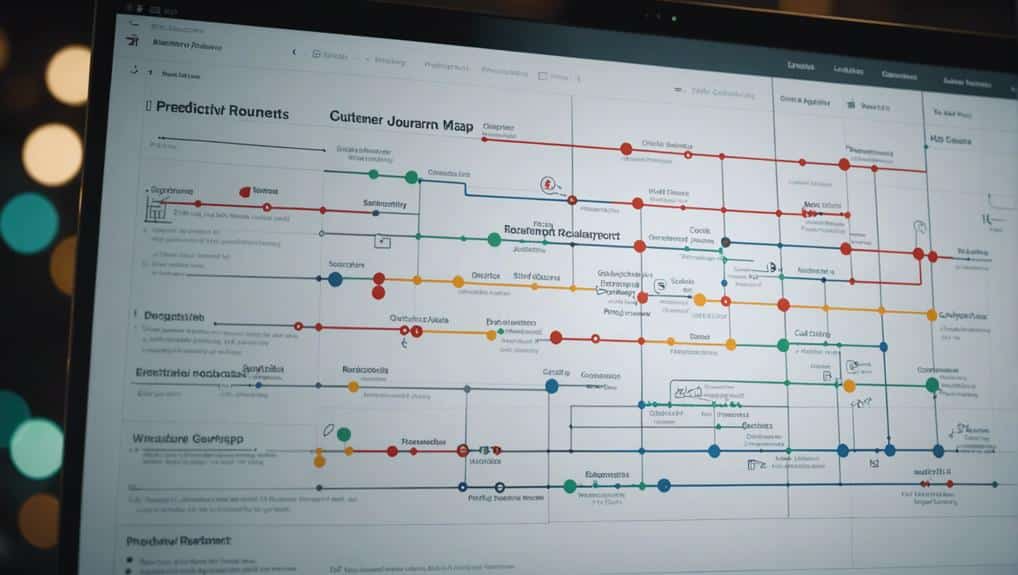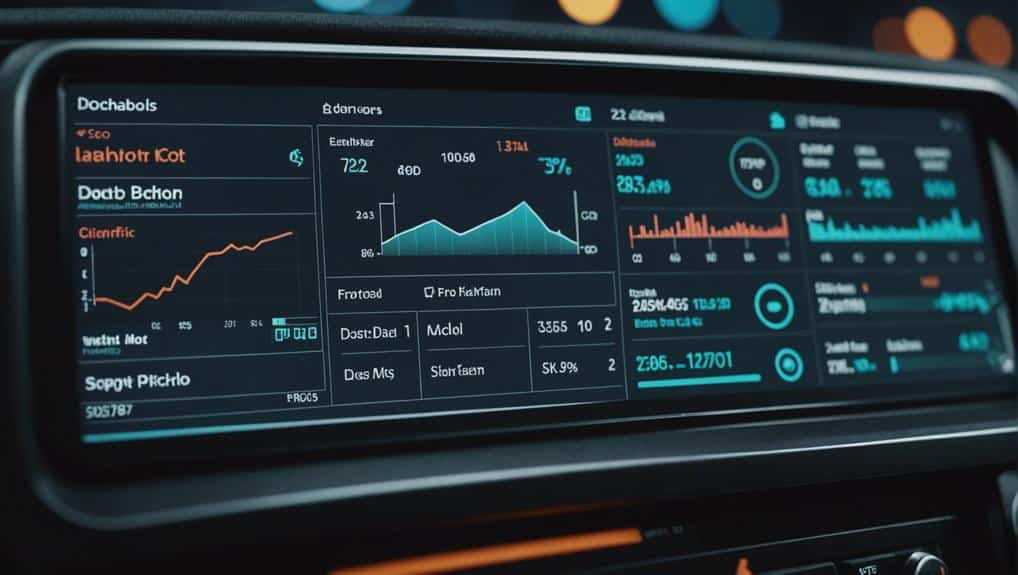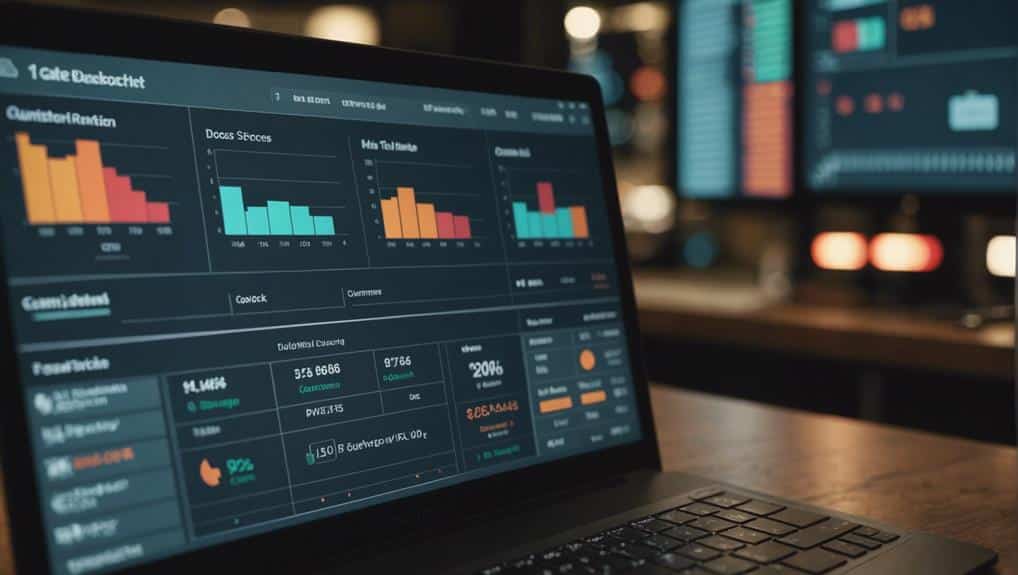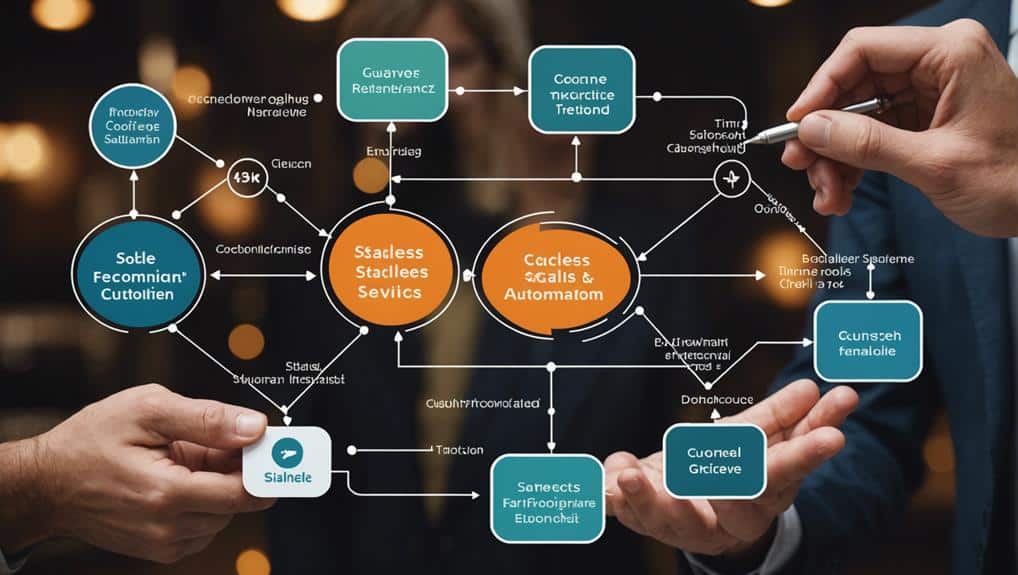Enhance customer retention through seamless sales automation services to stay ahead in today’s market. By using automation, you can provide personalized experiences and engage proactively with customers. This streamlines customer journeys, email campaigns, and loyalty programs, boosting satisfaction and loyalty. Affordable automation tools also help with operational efficiency and intelligent pricing decisions.
Enhance customer retention by focusing on metrics like Client Retention and Repeat Purchase Rate. These offer insights into customer behavior and help you make better decisions. Implementing automation can lead to a 10% increase in revenue and a 15% reduction in customer churn. Explore these insights to learn more about maximizing customer retention and profitability.
Automate Customer Retention for Loyal Launched CustomersKey Takeaways
- Utilize automation for tailored customer experiences.
- Streamline processes to boost customer loyalty.
- Implement behavior-based triggers for effective campaigns.
- Enhance engagement with personalized content.
- Drive revenue growth by retaining customers seamlessly.
Loyalty and Retention
Examining patron retention rates reveals the financial advantages of fostering loyalty within a consumer base. Customer retention strategies play an essential role in driving profitability for businesses. Data indicates that retaining customers can be between 5 to 25 times cheaper than acquiring new ones, making it cost-effective. Furthermore, a mere 5% increase in customer retention can significantly boost profits from 25% to 95%. This underlines the importance of nurturing customer loyalty through tailored experiences and loyalty programs.
Customer data has shown that repeat customers spend 67% more, emphasizing the value of retaining existing clientele. Additionally, loyal customers act as brand advocates, often referring friends and family to the business, contributing to natural growth. Tailored loyalty programs, adapted to specific preferences, have been proven to increase customer retention rates by up to 20%, highlighting the impact of personalized incentives on fostering loyalty within a consumer base.
Definition of Retention
The concept of client retention encompasses the strategic efforts to maintain the engagement and loyalty of existing clientele towards a business. Customer retention is vital as retained customers are more likely to be familiar with the brand, leading to increased profitability. Effective retention strategies revolve around providing tailored experiences, proactive communication, and consistent engagement to nurture relationships with existing customers.
Done-for-you sales automation services enhance customer retention by streamlining processes, tracking customer interactions, and providing personalized offers.
- Tailored Experiences: Adapting products or services to meet individual customers’ specific needs and preferences.
- Proactive Communication: Anticipating customer needs and reaching out before issues arise to show care and attention.
- Consistent Engagement: Maintaining regular interaction through various channels to keep the brand top-of-mind for customers.
Automating Customer Journeys

Utilizing automated processes in customer journeys has significantly impacted sales performance and operational efficiency. Automation in customer journeys can lead to a 10% increase in sales and a 12% reduction in marketing overhead. Seamless sales automation services are essential in tailoring customer interactions, resulting in a substantial 20% uplift in conversion rates. Businesses implementing automation in customer journeys witness a 15% boost in customer satisfaction and loyalty. Additionally, automated sales processes can slash response times by 50%, enhancing customer engagement and retention rates.
Email Campaigns
Email campaigns, an important aspect of automated marketing strategies, are essential for engaging customers and driving revenue growth. Personalized content and targeted approaches play a significant role in enhancing customer retention through automated email campaigns. Consider the following:
- Personalization: Tailoring emails to unique preferences boosts engagement and loyalty.
- Behavior-Based Triggers: Sending emails based on customer behavior increases click-through rates and improves overall campaign effectiveness.
- Automation Tools: Platforms like Mailchimp and HubSpot streamline the process, allowing for efficient management and optimization of email campaigns.
Loyalty Program Automation

Implementing automation in loyalty programs revolutionizes customer retention strategies by seamlessly tracking and rewarding customer engagement. Automated loyalty programs have shown remarkable results, with potential increases in customer retention by up to 27% and a boost in customer lifetime value of 30% or more. Through automation, loyalty programs can effectively monitor customer activity, enabling businesses to tailor tailored offers and incentives based on unique behavior.
This level of customization not only enhances the customer experience but also fosters a sense of belonging and loyalty to the brand.
Furthermore, implementing automated loyalty programs has proven to drive a significant 10% increase in the repeat purchase rate. By leveraging technology to streamline rewarding and incentivizing customer engagement, businesses can cultivate more robust relationships with their clientele, enhancing loyalty and increased profitability. Automated loyalty programs are an essential tool in the arsenal of customer retention automation, offering a powerful way to engage customers and drive repeat business.
Chatbots for Support
The integration of chatbots for customer support has revolutionized how businesses interact with their clientele, offering outstanding efficiency and tailored assistance. Chatbots can handle up to 80% of routine customer inquiries, improving response times and efficiency. They offer 24/7 support, ensuring customers receive assistance whenever they need it.
Additionally, chatbots can provide individualized recommendations based on customer interactions and preferences, enhancing the overall customer experience. By automating repetitive tasks, chatbots help reduce operational costs and allow staff to focus on more complex issues. This automation can lead to a 40% increase in customer satisfaction by providing instant and accurate responses.
Customers appreciate the quick resolutions and personalized attention they receive from chatbots, fostering a sense of loyalty and satisfaction. Businesses leveraging chatbots for support demonstrate a commitment to efficient service delivery and customer-centric solutions, ultimately enhancing customer retention rates.
Predictive Analytics Benefits

Utilizing predictive analytics in sales automation services offers businesses valuable insights into customer behavior, enabling proactive strategies for enhancing retention rates. By leveraging predictive analytics, companies can identify customers at risk of churning before it occurs, allowing for targeted retention efforts. Analyzing past customer behavior enables forecasting future actions and preferences, facilitating the implementation of tailored retention strategies tailored to unique needs.
Businesses that incorporate predictive analytics often experience a substantial increase in customer retention rates and overall revenue. These analytics tools provide actionable insights to optimize marketing efforts, enhance customer satisfaction, and boost retention outcomes. Integrating predictive analytics into sales automation services leads to more efficient and effective customer retention strategies, ultimately contributing to long-term business success. By adopting such data-driven approaches, businesses can stay ahead of customer needs and preferences, fostering stronger relationships and loyalty.
Communication Consistency
Consistent communication across all client touchpoints is essential in achieving high retention rates and fostering long-term relationships. Maintaining communication consistency is vital in today’s competitive market, where customer expectations are continually rising. Here are three key aspects highlighting the importance of communication consistency in enhancing customer retention and satisfaction:
- Building Trust: Consistent communication builds trust with customers, showing reliability and dedication to meeting their needs at every interaction point.
- Enhancing Customer Satisfaction: A lack of communication consistency can lead to a 20% decrease in customer satisfaction, emphasizing the need for seamless communication to guarantee a positive customer experience.
- Boosting Loyalty: Studies show that 78% of consumers are likelier to trust companies that deliver consistent messaging, indicating that seamless communication significantly increases customer loyalty and fosters long-term relationships.
Streamlined Processes

Efficient integration of sales automation processes greatly enhances operational productivity and reduces manual errors, substantially improving conversion rates and sales revenue. Streamlined sales automation processes improve customer retention by ensuring a seamless customer experience. Automating customer interactions and transactions improves operational efficiency and fosters stronger customer relationships.
By automating various touchpoints in the sales process, businesses can provide consistent and tailored customer experiences, ultimately leading to higher satisfaction levels and increased loyalty.
Moreover, streamlined processes through automation enable businesses to identify and address customer needs more effectively, further strengthening customer relationships. This, in turn, can result in higher customer retention rates and increased lifetime value. By integrating sales and marketing efforts through automation, companies can optimize their overall sales processes, leading to improved customer retention and enhanced revenue generation. Focusing on streamlined processes through automation is essential for businesses looking to boost customer retention and drive long-term success.
Follow-Ups Timing
Timely follow-ups are essential in enhancing customer retention rates and driving sales growth. Ideal follow-up frequency ensures that leads remain engaged without feeling overwhelmed by excessive communication. Tailored follow-up messages adapted to specific preferences can significantly improve the effectiveness of sales automation strategies.
Optimal Follow-Up Frequency
Strategically spaced follow-up interactions are essential in enhancing customer retention rates through sales automation services. The ideal follow-up frequency for customer retention typically ranges between 3-5 follow-ups after the initial contact, strategically spaced to maintain engagement without being overwhelming. Research indicates that following up within 5 minutes of the initial contact can significantly increase the likelihood of customer conversion by nine times, emphasizing the importance of timely interactions.
Automated follow-up sequences can be tailored to align with customer behavior and preferences, ensuring that the right message reaches the customer at the most opportune moment. Consistent follow-ups nurture leads and help foster relationships, leading to increased customer retention over time.
- Follow-up frequency of 3-5 interactions post-initial contact
- Strategic spacing to maintain engagement
- Tailored automated sequences aligned with customer preferences.
Personalized Follow-Up Messages
The research underscores the noteworthy impact of personalized follow-up messages, particularly concerning timing, on enhancing customer retention rates and fostering long-term relationships in sales automation services. Sending tailored follow-up messages within 24 hours of a customer’s purchase can notably increase customer retention by up to 60%. The importance of timing in follow-up messages cannot be overstated, as data suggests that responding within the first hour of customer contact can result in a 7x increase in engagement levels.
Moreover, utilizing automated follow-up messages tailored to customer behavior patterns can lead to a 48% higher revenue per customer than generic messages. Studies have consistently shown that customers are more inclined to make repeat purchases when they receive personalized follow-up messages aligned with their preferences. By leveraging sales automation services to deliver timely and tailored follow-ups, businesses can significantly enhance customer satisfaction and loyalty, ultimately driving long-term success.
Retention Metrics Overview

Analyzing retention metrics is essential for evaluating the effectiveness of customer retention strategies in a data-driven manner. These metrics provide valuable insights into customer behavior and satisfaction levels, aiding businesses in making informed decisions to enhance customer loyalty and drive revenue growth.
- Client Retention Rate (CRR): The CRR metric helps businesses understand the percentage of customers they have retained over a specific period, indicating the success of their retention efforts.
- Repeat Purchase Rate (RPR): RPR measures how frequently customers make repeat purchases, highlighting customer engagement and satisfaction with the products or services.
- Net Promoter Score (NPS): NPS is a crucial indicator of customer loyalty and satisfaction, enabling businesses to identify promoters, passives, and detractors to tailor retention strategies effectively.
Affordability Considerations
Cost-effective sales automation services enable businesses to streamline operations and enhance customer retention strategies. Affordable automation tools allow businesses to improve customer retention without incurring substantial costs. By implementing budget-friendly automation solutions, companies can achieve significant savings in both time and resources, making it a practical choice for companies of all sizes.
Small businesses, specifically, stand to benefit from affordable sales automation services as they can compete more effectively with larger competitors in the market. Additionally, choosing cost-effective automation tools can result in a high return on investment for businesses seeking to boost customer retention rates. Hence, affordability considerations in sales automation services contribute to operational efficiency and play an essential role in enhancing customer retention efforts.
Revenue Impact

How does implementing seamless sales automation services impact a company’s revenue generation potential? The revenue impact of sales automation services is significant, as evidenced by various statistics:
- Essential Customer Retention: Sales automation can lead to a 10% increase in revenue through enhanced customer retention strategies.
- Reduced Churn Rates: Implementing seamless sales automation services can reduce customer churn rates by 15%, leading to sustained revenue streams.
- Tailored Average Order Value: Companies utilizing sales automation services experience a 20% boost in average order value, directly impacting overall revenue positively.
These figures highlight the tangible benefits that sales automation services bring regarding revenue impact. By leveraging tailored sales interactions and streamlining processes, businesses can retain customers more effectively and drive higher revenues per transaction. The data-driven approach of sales automation services is pivotal in maximizing revenue potential while fostering strong customer relationships.
Blueprint for Revenue Optimization
Analyzing the revenue strategy overview is essential for businesses seeking to optimize their sales operations. Companies can streamline processes and increase efficiency by implementing automation tools effectively, leading to enhanced revenue generation. Tips for successful automation implementation can profoundly impact a business’s bottom line and drive sustainable growth.
Revenue Strategy Overview
Revenue strategy optimization is essential to maximizing sales efficiency and driving profitability through strategic pricing and sales tactics. When delving into the blueprint for revenue optimization, it becomes evident that:
- Data Analysis: Leveraging data to identify revenue growth opportunities is vital for developing a successful revenue strategy. Understanding customer behavior and market trends can guide pricing decisions and sales approaches.
- Automation Integration: Implementing marketing automation tools can enhance revenue strategy execution by automating repetitive tasks, enabling tailored customer interactions, and improving overall sales efficiency.
- Strategic Pricing: Setting prices intelligently based on market analysis and competitor benchmarking is necessary for revenue optimization. Strategic pricing not only influences revenue generation but also impacts customer perception and retention.
Automation Implementation Tips
Implementing automation in sales processes is a fundamental strategy for enhancing sales productivity and efficiency in today’s competitive business landscape. To effectively automate customer interactions and to improve customer retention, consider the following implementation tips:
| Automation Implementation Tips | Benefits | Statistics |
|---|---|---|
| Automate Customer Communication | – Increase in conversion rates | – Responding to leads within 5 minutes can boost conversions by 900% |
| Implement Lead Nurturing Workflows | – Increase in qualified leads | – Companies experience a 451% rise in qualified leads with automation |
| Streamline Sales Data Entry | – More time for deal closing | – Automation can reduce manual data entry time by 70% |
| Set Clear Sales Automation Goals | – Higher quota achievement | – Sales representatives see a 53% increase in quota achievement with automation |
Frequently Asked Questions
How Can You Enhance Customer Retention?
To increase customer retention rates, businesses can individualize experiences, provide outstanding customer service, offer loyalty programs, and implement sales automation. These strategies enhance customer satisfaction, streamline processes, and foster long-term relationships, ultimately boosting profitability and sales growth.
How Technology Helps in Customer Retention?
Technology guards customer loyalty, wielding tailored communication, streamlined processes, and data analytics. It nurtures relationships, shields against churn, and cultivates lasting bonds through seamless experiences and targeted strategies, fostering customer retention.
How Does CRM Improve Customer Retention?
CRM systems enhance customer retention by centralizing data for tailored interactions, anticipating needs, and enabling targeted marketing campaigns. Businesses utilizing CRM experience a 25% increase in sales productivity and a 35% boost in customer satisfaction, leading to a 36% higher retention rate.
What Are the Four Stages of Customer Retention?
Customer retention progresses through acquisition, onboarding, engagement, and loyalty stages. Analogous to nurturing a seed into a flourishing plant, each stage cultivates a deeper connection. Marketing, education, tailoring, and advocacy form the foundation for lasting customer relationships.
Conclusion
Enhance customer retention with seamless sales automation services. You can offer personalized experiences that meet customer expectations by automating customer journeys. This helps build long-term relationships and boosts customer satisfaction. Use automation tools to create targeted email campaigns and loyalty programs, improving customer engagement and loyalty.
A strong customer retention strategy focuses on metrics like churn rate and customer behavior. These insights help you understand your loyal customer base and make informed decisions. Implementing marketing automation and customer feedback tools can increase customer retention and decrease churn rates. These tools are essential for understanding and meeting the needs of individual customers.
The affordability of automation makes it a smart choice for any business looking to optimize their marketing strategy. You can reduce costs and improve customer satisfaction by automating personalized interactions and customer service processes. Use Customer Relationship Management systems to manage your customer list and track key metrics, ensuring a seamless customer experience and higher customer loyalty. Embracing automation is necessary in today’s competitive marketplace to maintain a loyal customer base and drive business growth.

Erik Remmel is a co-founder of Launched, a platform that helps businesses grow through AI-powered marketing, automation, and lead generation. He focuses on building scalable systems that convert cold leads into customers while streamlining operations with smart, AI-driven workflows.

